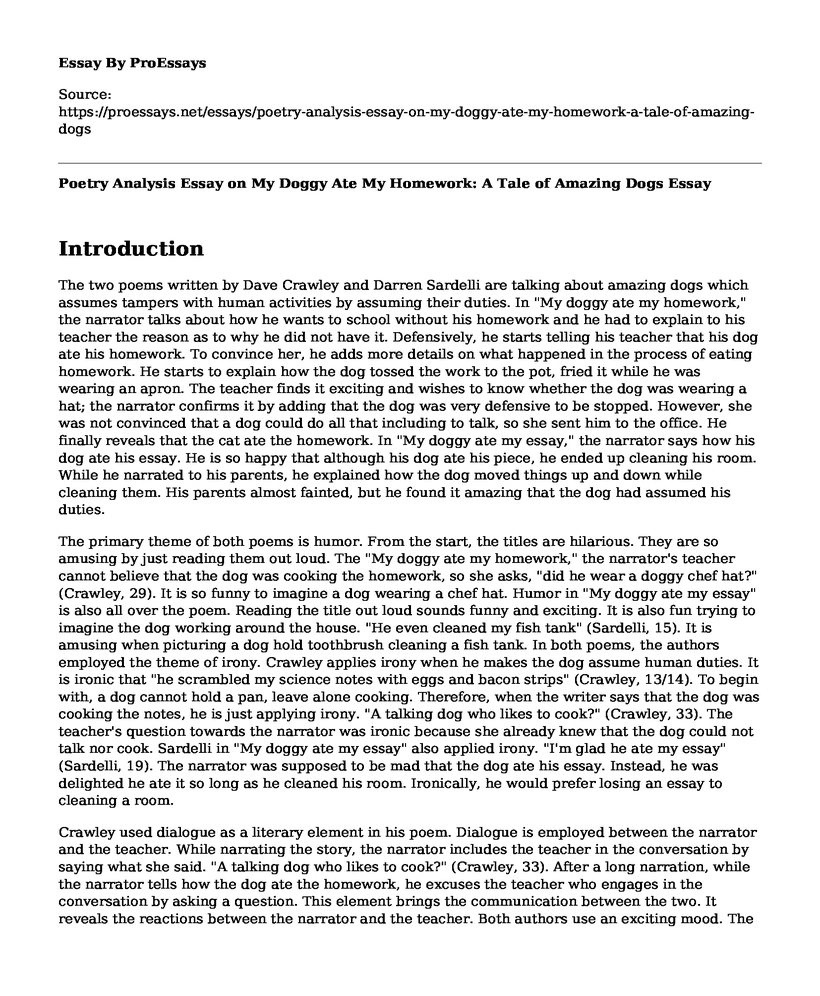Introduction
The two poems written by Dave Crawley and Darren Sardelli are talking about amazing dogs which assumes tampers with human activities by assuming their duties. In "My doggy ate my homework," the narrator talks about how he wants to school without his homework and he had to explain to his teacher the reason as to why he did not have it. Defensively, he starts telling his teacher that his dog ate his homework. To convince her, he adds more details on what happened in the process of eating homework. He starts to explain how the dog tossed the work to the pot, fried it while he was wearing an apron. The teacher finds it exciting and wishes to know whether the dog was wearing a hat; the narrator confirms it by adding that the dog was very defensive to be stopped. However, she was not convinced that a dog could do all that including to talk, so she sent him to the office. He finally reveals that the cat ate the homework. In "My doggy ate my essay," the narrator says how his dog ate his essay. He is so happy that although his dog ate his piece, he ended up cleaning his room. While he narrated to his parents, he explained how the dog moved things up and down while cleaning them. His parents almost fainted, but he found it amazing that the dog had assumed his duties.
The primary theme of both poems is humor. From the start, the titles are hilarious. They are so amusing by just reading them out loud. The "My doggy ate my homework," the narrator's teacher cannot believe that the dog was cooking the homework, so she asks, "did he wear a doggy chef hat?" (Crawley, 29). It is so funny to imagine a dog wearing a chef hat. Humor in "My doggy ate my essay" is also all over the poem. Reading the title out loud sounds funny and exciting. It is also fun trying to imagine the dog working around the house. "He even cleaned my fish tank" (Sardelli, 15). It is amusing when picturing a dog hold toothbrush cleaning a fish tank. In both poems, the authors employed the theme of irony. Crawley applies irony when he makes the dog assume human duties. It is ironic that "he scrambled my science notes with eggs and bacon strips" (Crawley, 13/14). To begin with, a dog cannot hold a pan, leave alone cooking. Therefore, when the writer says that the dog was cooking the notes, he is just applying irony. "A talking dog who likes to cook?" (Crawley, 33). The teacher's question towards the narrator was ironic because she already knew that the dog could not talk nor cook. Sardelli in "My doggy ate my essay" also applied irony. "I'm glad he ate my essay" (Sardelli, 19). The narrator was supposed to be mad that the dog ate his essay. Instead, he was delighted he ate it so long as he cleaned his room. Ironically, he would prefer losing an essay to cleaning a room.
Crawley used dialogue as a literary element in his poem. Dialogue is employed between the narrator and the teacher. While narrating the story, the narrator includes the teacher in the conversation by saying what she said. "A talking dog who likes to cook?" (Crawley, 33). After a long narration, while the narrator tells how the dog ate the homework, he excuses the teacher who engages in the conversation by asking a question. This element brings the communication between the two. It reveals the reactions between the narrator and the teacher. Both authors use an exciting mood. The atmosphere within which the narrators speak is lively and full of excitement. They are both excited that the dog ate their work. "I thought it was amazing" (Sardelli, 17). The narrator is happy and cannot hide his joy over the fantastic cleaning work the dog did for him. He did not even care that his essay was eaten. The good deeds outweighed the wicked deed. The mood element indicates the presence of serenity of the story. It is a way of classifying the story by differentiating it from revealing conflict stories. Another feature element used in both poems is personification. A dog is given human qualities and abilities to do what a man can do. In Crawley's poem, the cat is also personified at the end of the poem. Personification in both poems helps in giving them meaning. The two stories show the value and importance of a dog. They also try to discredit the human and credit the dog, especially in Sardelli's poem. "He cleaned up my dirty closet" (Sardelli, 3). In this line, a dog is credited and human is discredited. The author is trying to show the value of a dog over that of a man. Personification is also shown where a dog can clean the narrator's closet.
Works Cited
Crawley, Dave. "My Doggy Ate My Homework by Dave Crawley." Poetry Foundation, 2019, www.poetryfoundation.org/poems/47148/my-doggy-ate-my-homework. Accessed 12 June 2019.
Sardelli, Darren. "My Doggy Ate My Essay by Darren Sardelli." Poetry Foundation, 2019, www.poetryfoundation.org/poems/145936/my-doggy-ate-my-essay. Accessed 12 June 2019.
Cite this page
Poetry Analysis Essay on My Doggy Ate My Homework: A Tale of Amazing Dogs. (2023, Jan 22). Retrieved from https://proessays.net/essays/poetry-analysis-essay-on-my-doggy-ate-my-homework-a-tale-of-amazing-dogs
If you are the original author of this essay and no longer wish to have it published on the ProEssays website, please click below to request its removal:
- Literary Analysis on The Old Man and the Sea
- American Noirs Comparative Essay
- The Painted Bird by Jerzy Kosinski - Literary Analysis Essay
- How I Got that Name by Marilyn Chin Essay Example
- The Fall of the House of Usher Analysis Paper Example
- Analysis of "Fences" by August Wilson
- Essay Example on Vivid Description in Literature: Elizabeth & Melissa's Room in College







